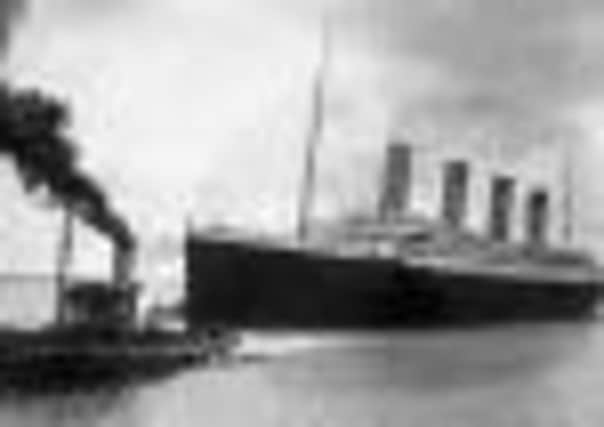How The Scotsman reported the Titanic disaster


Earlier in the week The Scotsman had reported on the magnificent scale of the Titanic, “the largest vessel afloat”.
11 April 1912: WHITE STAR LINER’S MAIDEN VOYAGE
THE departure yesterday, from Southampton of the newest ocean giant, the Titanic, of the White Star Line, was an event that marks the latest progress in modern shipbuilding. Nominally of the same size as her sister ship, the Olympic, 45,000 tons, she proves upon final measurement to be about a thousand tons bigger, this being in consequence of some three inches extra in length, coupled with technical considerations which are taken into account by those upon whom the duty rests of officially determining the tonnage of the modern steamship. To the Titanic therefore, belongs the honour of being the largest vessel afloat.


Advertisement
Hide AdAdvertisement
Hide AdThen came the earliest reports of the passenger liner’s collision with an iceberg.
16 April 1912: HOME RULE QUESTIONS - THE TITANIC COLLISION
In reply to Mr Louch (L, Islington, W.), The PRESIDENT of the BOARD of TRADE said he received a short time ago the following telegram from the White Star Office, Liverpool:—
“Only information telegram from New York as follows:— ‘Newspapers’ wireless reports advise Titanic collision with iceberg at 41.46 north, 50.14 west. Women being put into lifeboats. Steamer Virginian expects to reach Titanic 10AM. Olympic and Baltic proceeding to Titanic.’ Have no direct information.”
The terrible news was confirmed the following day.
17 April 1912: “REACHED Titanic’s position at daybreaK. “Found boats and wreckage only.” These grim words, transmitted to the headquarters of the White Star Line from the Carpathia and Olympic, sum up the most that is accurately known concerning the magnificent vessel — the pride of Britain’s merchant marine — which only this day week sailed from Southampton on her first and last voyage across the Atlantic.
The death toll soon became apparent when the Carpathia reported on its mission to the site of the sinking.
17 April 1912: DEATH TOLL OF 1500 - 868 SURVIVORS ON THE CARPATHIA
THERE is now, unhappily, no doubt that the disaster to the Titanic is one of the most appalling catastrophes in maritime history. The gigantic vessel carried 1465 passengers and 903 crew, or in all 2358 souls. The total number of survivors is officially declared at New York to bo 868, so that it would appear the number who have perished reached the awful figure of 1490.
Advertisement
Hide AdAdvertisement
Hide Ad18 April 1912: NEWS OF CARPATHIA - “750 SURVIVORS ABOARD”. EXPECTED AT NEW YORK TO-NIGHT
THERE is uncertainty as to the exact number of survivors, of the Titanic disaster, on board the Carpathia. Wireless messages from the Carpathia state that she has 705 survivors on board. According to the official statement published yesterday, the number of survivors is 868; and the figures705 may not include the members of the crew who were saved. It is now known that the second, third, fourth, and fifth officers and the second wireless operator of the Titanic are among the survivors.
18 April 1912: SEARCHING FOR THE DEAD - CABLE STEAMER’S SAD MISSION
Halifax, N.S., April 17. The cable steamer Mackay Bennett sailed at one o’clock to-day for the scene of tho Titanic disaster to search for the bodies of victims. Just prior to sailing she took on board 600 roughly constructed pinewood coffins. An undertaker and a clergyman are on board, and the inference is that the bodies as recovered will be accorded proper sea-burial.
It did not take long for questions to be asked about the safety measures on board the Titanic.
18 April 1912: WERE THERE ENOUGH BOATS?
To-day, while horror and sympathy are unabated, and details are distressingly lacking, moro attention is being paid to the broader aspects of tho disaster. How was it that the Titanic apparently succumbed to a danger of the existence of which she is reported to have been aware? Could everybody have been saved had there been boats enough? What is the explanation of the fallaciously optimistic wireless reports with which on Monday the air teemed? Is the tendency of modern trans-oceanic trade to sacrifice absolutely to luxury, speed and commercial expediency? All these questions, it may be urged, may well be deferred until the knowledge necessary to their exact consideration is available.
• The Scotsman Archive can be accessed at archive.scotsman.com